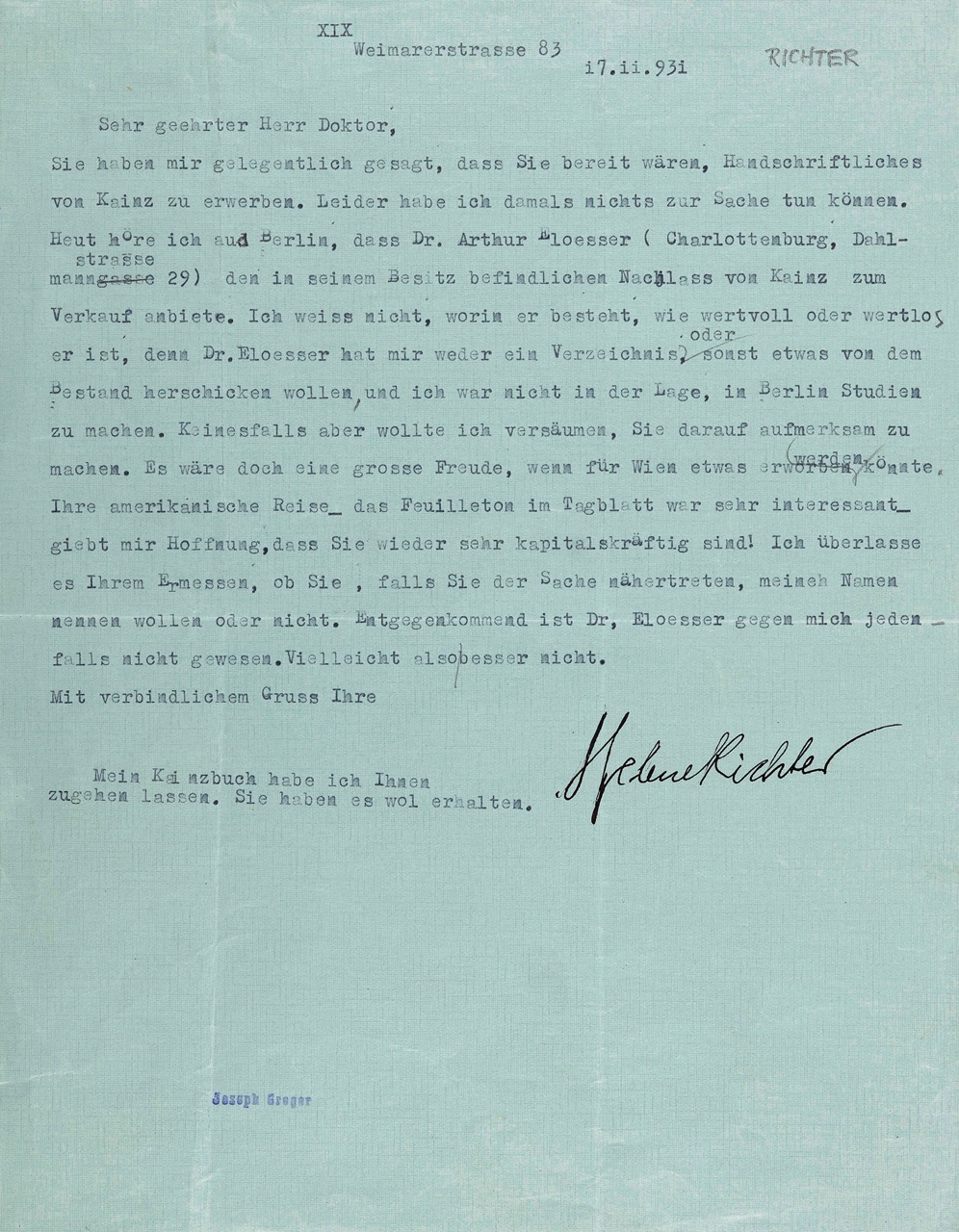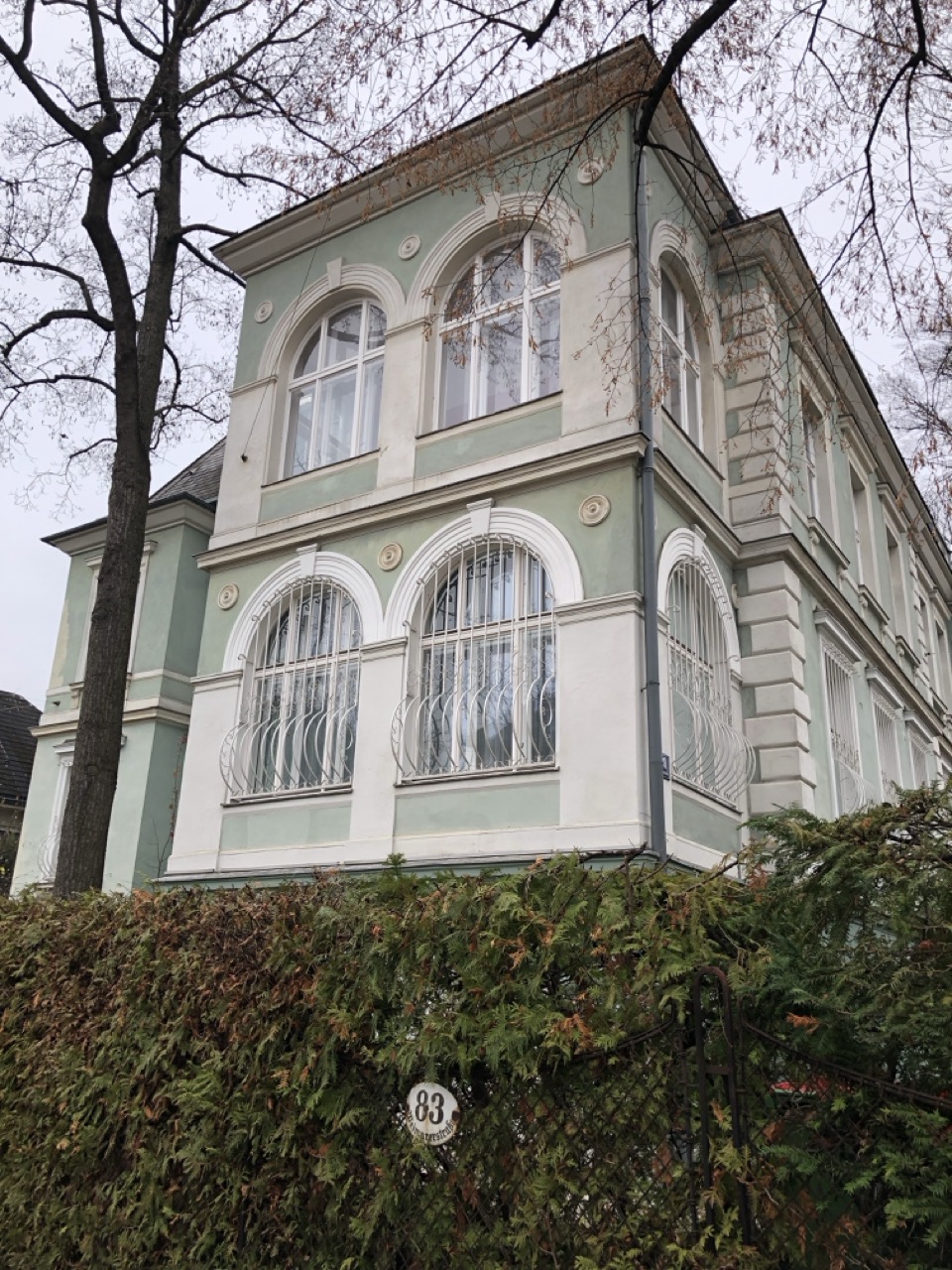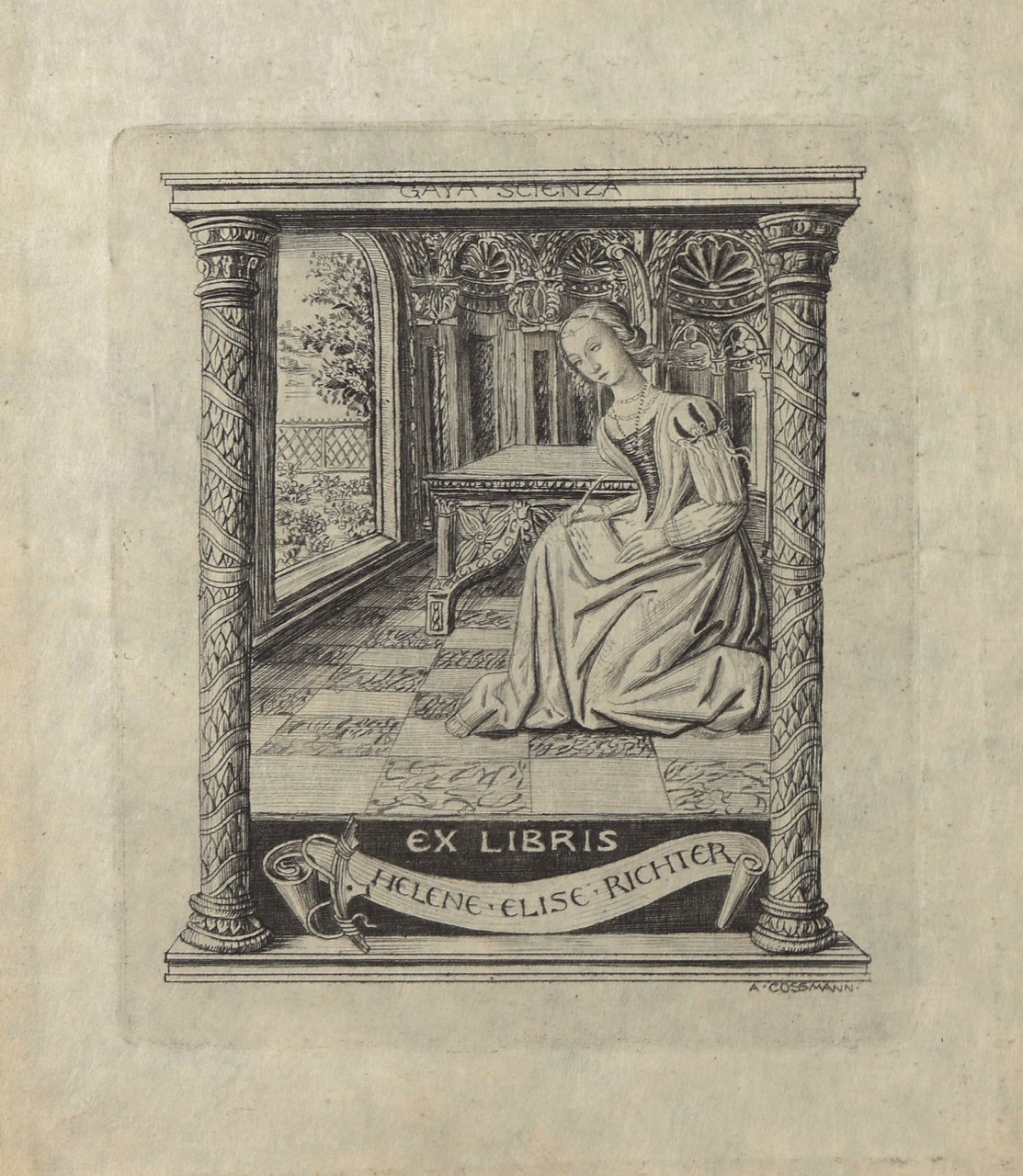Vienna, 10 October, 1931
Visiting the Cottage – Weimarerstrasse 83
Gathering Place for Intellectuals, Art and Theatre Enthusiasts, Feminists, and Thoughtful Women and Men!
Our reporter, Birgit Peter, visited the legendary salon of the
prominent Viennese sisters, Helene and Elise Richter
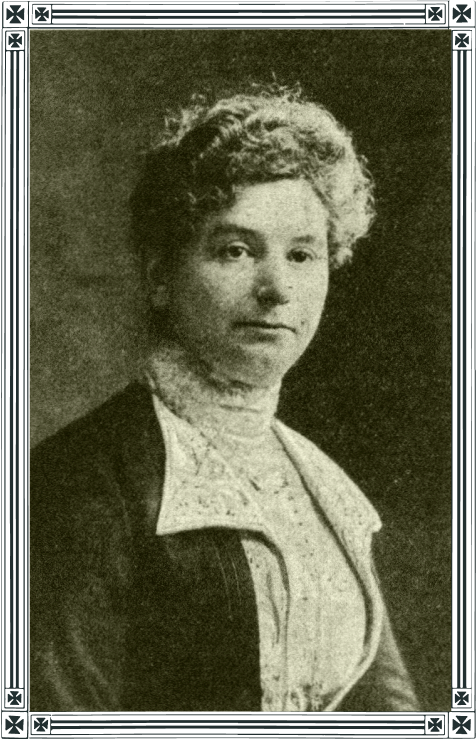
Fräulein Dr. Elise Richter, in: Wiener Bilder, Nr. 38, 18.9.1907, S. 5.
Source: ANNO /Österreichische Nationalbibliothek
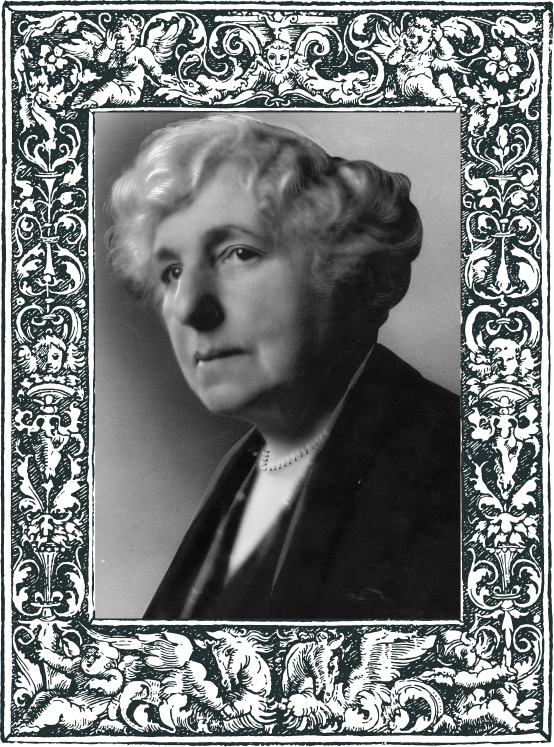
© ÖNB-Bildarchiv / picturedesk.com,
sign. Pf 47.910:C(1)
The Richter Sisters’ Salon
In the years before the Great War, the house at Carl Ludwig Gasse 69, now Weimarerstrasse 83, was a meeting point for scholars and prominent figures in the arts. Here, in the tasteful cottage, which was designed by Elise Richter herself, discussions unfold weekly, and bring together diverse personalities such as women’s rights advocates Rosa Mayreder and Marianne Hainisch, the refined composer Maia von Kralik, and the rigorous music critics Richard von Kralik (Maia’s husband as well as a composer) and Max Kalbeck. Of course, the unforgettable actor and director of the Burgtheater, Hugo Thimig, was a frequent guest, sharing with Helene a love for the historical artifacts of this world stage. The late classical philologist Hans von Arnim was also often present, and his knowledge of Aristotle and Euripides led to fascinating intellectual exchanges.
Gaya Scienzia! These exceptional sisters embody the joyful pursuit of knowledge. Helene, who celebrated her 70th birthday this summer, and her sister Elise, four years younger, showed us that as women, we should not shy away from conquering the temples of science and art.
Elise Richter
Who would have thought, 30 years ago, that a young doctoral graduate would submit her habilitation thesis in Romance philology at the venerable University of Vienna and now head the Phonetics Institute? Elise Richter reminds us not to be discouraged by male voices claiming that a woman as a professor would be unbearable for students! She may not yet hold the title of university professor or receive payment for her teaching, but we trust in our country’s progressive forces that will grant her the full university professorship by her 70th birthday at the latest.
Helene Richter
Our biographer of the Burgtheater! Helene Richter’s book Unser Burgtheater, written just before the end of the dreadful war, helped us believe in the future of this beloved stage, which symbolizes our love for Vienna. The profoundly versatile Helene, an Anglist, theatre historian, and biographer of the greatest actors, such as the unforgettable Josef Lewinsky and the still deeply mourned Josef Kainz, has finally been honoured as an honorary citizen of the City of Vienna, and has been twice awarded for honorary doctorates, from the University of Erlangen and the University of Heidelberg! More than deserving, Helene Richter, surrounded by her select theatre library and immersed in her research on Shakespeare, George Eliot, the English women’s movement, and whatever else captures her heart and mind, continues to enrich us.
May these challenging times soon pass – they have, as for most of us, made the lives of the famous sisters more austere. Nevertheless, the door is always open to scholarly and refined friendships that bravely confront the struggles of daily existence.
‘The two sisters complemented each other symbiotically. One cannot be analyzed without the other. Their work and lives were intertwined. They formed a community of discourse and functioned as one.’
n
Robert Tanzmeister, Romanicist
Helene Richter
born 4 August 1861, Vienna
died 8 November 1942, Theresienstadt concentration camp
h
Elise Richter
born 2 March 1865, Vienna
died 21 June 1943, Theresienstadt concentration camp
Biographies
‘They lived emancipated and self-determined together, even contemplating adopting a child.’
Thierry Elsen, Romanicist
Helene and Elise Richter were born into an affluent, assimilated Jewish family.
They were the daughters of Emilie Richter (née Lackenbacher, 1832–1889) and Maximilian Richter (1824–1890), Chief Physician of the Southern Railway Company Vienna-Trieste. Since women were denied access to academic education at that time, the sisters received private tutoring in their parental home, where culture, education, and learning held a high value. While the older sister, Helene, continued her education through self-study and attended the University of Vienna as a guest auditor, Elise, who was four years younger, became the first woman to graduate from the Akademisches Gymnasium in Vienna.
Subsequently, Elise was admitted to the Faculty of Philosophy at the University of Vienna, where she became the first woman to habilitate (qualify for teaching at a German or Austrian university) in 1905. She went on to teach linguistics and phonetics at the University of Vienna, once again as the first woman in this role, embarking on an academic career in teaching and research in romance linguistics, literature, and phonetics. Helene chose a path outside the university. She made a name for herself as a translator, Anglicist, critic, and theatre historian, becoming one of Vienna’s most renowned theatre intellectuals. Her works include a two-volume history of English Romanticism and monographs on significant English poets including William Blake and George Eliot. In the field of theatre science, she is known as an expert on the Burgtheater. She authored works including Unser Burgtheater (‘Our Burgtheater’) in 1918, the commemorative publication Josef Lewinsky in 1926, and a biography of Josef Kainz (1858–1910). Unfortunately, her three-volume work Die drei großen Tragödinnen (‘The Three Great Tragediennes’) of the Burgtheater in the nineteenth century existed only as a typescript. In 1931, Helene Richter received honorary doctorates from the Universities of Heidelberg and Erlangen and was named an honorary citizen of Vienna.
With the inheritance from their deceased parents, the sisters were able to embark on numerous journeys across Europe and North Africa and jointly acquire a house in Vienna’s Döbling district, where they lived side by side until their deportation.
Their home hosted one of Vienna’s last salons, regularly attended by prominent figures from art, culture, and science.
g
After the events of March 1938, Elise Richter was forcibly retired, and her salary was terminated, leaving the sisters penniless. They were also compelled to pay the ‘Jewish property tax’, exacerbating their financial hardship, and forcing them to sell parts of their valuable library. This, in turn, led to the University Library Cologne, with the involvement of the Austrian National Library, confiscating their entire collection. In March 1942, the sisters were forced to move to the Jewish nursing home in Seegasse, and in October, they were deported to the Theresienstadt concentration camp. Helene passed away in November of the same year, and Elise in June 1943, due to the appalling conditions of the camp.
What Remains?
k
On 10 March 1942, the Richter sisters, Helene and Elise, were forcibly relocated from their former home in Döbling to the Jewish retirement home at Seegasse 16 in the 9th district. Only seven months later, on 9 October 1942, they were deported from the Vienna Aspangbahnhof along with 1,300 other persecuted individuals to the Theresienstadt concentration camp. There, Helene was declared dead after only six weeks, on 8 November, with the cause of death listed as colitis. Elise endured the cruel conditions of malnutrition, disease, and mental anguish for eight more months. She was declared dead on 21 June 1943, with the cause of death also listed as colitis and pneumonia.
As early as November 1938, both of the Richter sisters were pushed out of their professional lives due to being Jewish and, having no source of income, had to sell parts of their library. Moreover, the elderly sisters declined the support of the International Federation of University Women with the argument that ‘you don’t transplant old trees’. Thus, they did everything in their power, despite being isolated and harassed, to remain in their beloved Vienna. Consequently, they sold 100 of the most valuable books from their library to pay the ‘wealth tax’. However, no payment was made to the Richter sisters after they sent the works to the library in Cologne. ‘It was the first hearse that took them away’, Elise Richter wrote in her first letter to the library on 24 August 1941.
h
Although Helene Richter was considered the more successful sister during her lifetime, there are now only a few traces left to remember the theatre scholar. Elise Richter has been commemorated since the 1980s as the first woman to earn habilitation at the University of Vienna, with the Richter-Tor (a memorial gate to the campus) in Alserstraße, as well as a lecture hall named after her; a monument in the university’s Arkadenhof; and a scholarship for women established in her memory for pursuing habilitation from the Austrian Research Promotion Fund. Dedicated female researchers are responsible for the 1997 publication of Elise Richter’s memoirs, titled Summe des Lebens (‘Sum of Life’), which was written in 1940. The house at Weimarerstrasse 83 still stands, with neither a Stolperstein (stumbling block) nor a memorial plaque to remind us of the two sisters.



